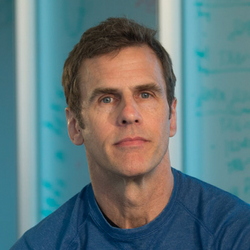In this column, I ask neuroscience professors from around the world the same five questions. Read on to learn more about their research, careers and goals for neuroscience in the future.

Interview with Read Montague, Ph.D.
Read Montague’s work focuses on computational neuroscience – the connection between physical mechanisms present in real neural tissue and the computational functions that these mechanisms embody. His early theoretical work focused on the hypothesis that dopaminergic systems encode a particular kind of computational process, a reward prediction error signal, similar to those used in areas of artificial intelligence like optimal control. In pursuit of testing these ideas in humans, Montague founded the Human Neuroimaging Lab at Baylor College of Medicine in Houston, Texas, and pursued functional neuroimaging experiments analogous to those used in other model species.
From 2005 to 2006, he was a member of the Institute for Advanced Study in Princeton, New Jersey, where he focused on game theory and its potential use as a probe of psychopathology. In 2006, he was the founding director of the Computational Psychiatry Unit at Baylor College of Medicine.
In 2011, Montague moved to the department of physics at Virginia Tech, received a Principal Research Fellowship from The Wellcome Trust, and became a principal at The Wellcome Centre for Neuroimaging at University College London (UCL). At UCL, he also serves as adjunct faculty at the Gatsby Computational Neuroscience Unit and participating faculty member of the University College London/Max Planck Institute Centre for Computational Psychiatry and Ageing. He is actively engaged in translating computational neuroscience into the domain of mental health through work in Computational Psychiatry. His group has recently pioneered new approaches to sub-second neurotransmitter measurements in conscious humans.
Over the past decade, he was a member of the MacArthur Foundation Network on Neuroscience and Law with a particular interest in the mental states project(s). His laboratory uses theoretical, computational, and experimental approaches to the problems of mental health and its derangement by disease and injury. Work in the laboratory is supported by the National Institutes of Health, National Science Foundation, The Kane Family Foundation, Autism Speaks, The MacArthur Foundation, The Dana Foundation, and The Wellcome Trust.
1. What inspired you to pursue neuroscience as a career?
As a college undergraduate (first engineering then mathematics), I worked as a computer programmer for a quantum chemist as a kind of ‘side job’. I would compute solutions to problems about scattering and other phenomena using standard equations and approximations from non-relativistic quantum mechanics. I got very fast at doing the work, but I never felt like I understood his ‘narratives’ about the quantum mechanics part. He had these extremely lush narratives in his head that acted as a kind of liason to his sense of understanding the results spit out by the mathematical models. I started to see this as my lack of understanding of what it meant for anyone to understand something… These interactions have never left me and inspired a real interest in how neural tissue supports thought and the feelings that attend understanding.
2. What do you think is the most important goal of neuroscience research?
Neuroscience has many goals. First, the connection between the operation and organization of neural tissue and the behaviors, thinking and feeling it supports. That’s a spectrum of basic science goals and we’re in the midst of a renaissance of methodologies for connecting the details of neural function to behavior in many species including humans. The second is the need to understand mental dysfunction in humans and its dependence on disease and injury in the nervous system. Third, I think we are entering an era when we all want to use neuroscience knowledge to change the world for the better and mental illness is just one domain where change is happening. There are many examples where we would like to understand how to use neuroscience to make better lives for ourselves individually and in the composite: how do we design (or change) medical, economic, and legal systems that comport with the way our minds work, but also seeking social justice in the process. How to think about the integration or use of neuroscience knowledge and technology isn’t just a science question and will require lots of kinds of minds seeking good solutions.
3. What are the main topics and goals of your research?
My work centers on a computational understanding of neuromodulatory systems in the brain and the way they impact perception, action, and valuation. These systems use neurotransmitters more or less familiar to the public – dopamine, serotonin, norepinephrine, acetylcholine, and a host of other compounds including peptides. Vast numbers of people take medication that influences one or more of these systems in an effort to concentrate better, improve depressed mood, treat drug addiction, and so on. What we are learning now is that these systems play many roles and do so by interacting with one another so it’s a tricky set of problems. The interesting feature here is that there is now a class of learning model, called reinforcement learning, that captures the way some of these systems behave in simple situations. Reinforcement learning is now also a productive approach to artificial learning systems and so has garnered lots of attention in terms of the kinds of systems we might engineer.
The second area of interest to me is Computational Psychiatry, which uses modeling approaches to understand neural circuit function and seeks to apply this to important questions in mental disease and dysfunction. It’s a growing area and very attractive to ambitious young people who want their science ‘to make a difference’. At this stage in my career, I’m very interested in attracting young people to the area.
4. What accomplishment do you think is the most important out of your own research?
I have no idea.
5. What do you hope to accomplish in the next 10 years in the field of neuroscience?
We have developed some new technology to measure neuromodulators (dopamine, serotonin, norepinephrine, pH, and other things) using standard electrodes and at really fast rates. These methods are going to uncover some really new information in humans as to how neuromodulatory systems work at fast time scales and how they collectively interact during normal perception. My goal, given these developments, is to make these methods non-invasive and thus open up the possibility of eavesdropping safely on fast neurochemistry in conscious human subjects.
Bonus question: What is your advice to a teenager who wants to learn more about neuroscience?
Follow your passion.
